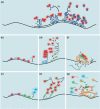Strength in numbers: quantitative single-molecule RNA detection assays
- PMID: 25645249
- PMCID: PMC5024021
- DOI: 10.1002/wdev.170
Strength in numbers: quantitative single-molecule RNA detection assays
Abstract
Gene expression is a fundamental process that underlies development, homeostasis, and behavior of organisms. The fact that it relies on nucleic acid intermediates, which can specifically interact with complementary probes, provides an excellent opportunity for studying the multiple steps--transcription, RNA processing, transport, translation, degradation, and so forth--through which gene function manifests. Over the past three decades, the toolbox of nucleic acid science has expanded tremendously, making high-precision in situ detection of DNA and RNA possible. This has revealed that many--probably the vast majority of--transcripts are distributed within the cytoplasm or the nucleus in a nonrandom fashion. With the development of microscopy techniques we have learned not only about the qualitative localization of these molecules but also about their absolute numbers with great precision. Single-molecule techniques for nucleic acid detection have been transforming our views of biology with elementary power: cells are not average members of their population but are highly distinct individuals with greatly and suddenly changing gene expression, and this behavior of theirs can be measured, modeled, and thus predicted and, finally, comprehended. For further resources related to this article, please visit the WIREs website.
Conflict of interest: The authors have declared no conflicts of interest for this article.
© 2015 The Authors. WIREs Developmental Biology published by Wiley Periodicals, Inc.
Figures



Similar articles
-
Real-time assays with molecular beacons and other fluorescent nucleic acid hybridization probes.Clin Chim Acta. 2006 Jan;363(1-2):48-60. doi: 10.1016/j.cccn.2005.04.037. Epub 2005 Aug 18. Clin Chim Acta. 2006. PMID: 16111667 Review.
-
Imaging of RNA in live cells.Curr Opin Chem Biol. 2011 Dec;15(6):806-12. doi: 10.1016/j.cbpa.2011.10.006. Epub 2011 Nov 4. Curr Opin Chem Biol. 2011. PMID: 22055496 Review.
-
Probe design for the effective fluorescence imaging of intracellular RNA.Chem Rec. 2013 Apr;13(2):209-17. doi: 10.1002/tcr.201200026. Epub 2013 Mar 13. Chem Rec. 2013. PMID: 23495145
-
Visualizing nucleic acids in living cells by fluorescence in vivo hybridization.Methods Mol Biol. 2010;659:239-46. doi: 10.1007/978-1-60761-789-1_17. Methods Mol Biol. 2010. PMID: 20809316
-
Single molecule imaging of RNA in situ.Methods Mol Biol. 2011;714:3-13. doi: 10.1007/978-1-61779-005-8_1. Methods Mol Biol. 2011. PMID: 21431731
Cited by
-
Spatial transcriptomics using combinatorial fluorescence spectral and lifetime encoding, imaging and analysis.Nat Commun. 2022 Jan 10;13(1):169. doi: 10.1038/s41467-021-27798-0. Nat Commun. 2022. PMID: 35013281 Free PMC article.
-
Single Molecule Fluorescence In Situ Hybridization (smFISH) Analysis in Budding Yeast Vegetative Growth and Meiosis.J Vis Exp. 2018 May 25;(135):57774. doi: 10.3791/57774. J Vis Exp. 2018. PMID: 29889208 Free PMC article.
-
Terminal Deoxynucleotidyl Transferase Mediated Production of Labeled Probes for Single-molecule FISH or RNA Capture.Bio Protoc. 2018 Mar 5;8(5):e2750. doi: 10.21769/BioProtoc.2750. eCollection 2018 Mar 5. Bio Protoc. 2018. PMID: 34179277 Free PMC article.
-
Quantitative, in situ analysis of mRNAs and proteins with subcellular resolution.Sci Rep. 2017 Nov 28;7(1):16459. doi: 10.1038/s41598-017-16492-1. Sci Rep. 2017. PMID: 29184166 Free PMC article.
-
Bayesian Estimation for Stochastic Gene Expression Using Multifidelity Models.J Phys Chem B. 2019 Mar 14;123(10):2217-2234. doi: 10.1021/acs.jpcb.8b10946. Epub 2019 Mar 5. J Phys Chem B. 2019. PMID: 30777763 Free PMC article.
References
Publication types
MeSH terms
Substances
LinkOut - more resources
Full Text Sources
Other Literature Sources
Research Materials
Miscellaneous

